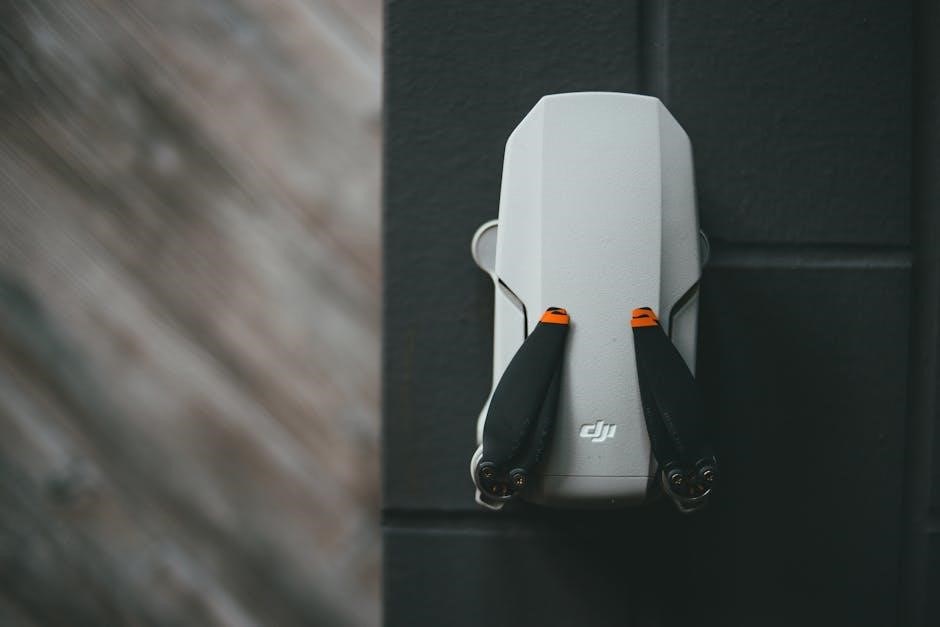A fly rod guide size chart is a crucial tool for anglers and rod builders, helping determine optimal guide sizes and spacing for various rod lengths and line weights.
1.1 Importance of Guide Size Charts for Anglers
Guide size charts are essential for optimizing fly rod performance, ensuring proper line control, and enhancing casting accuracy. They help anglers select the right guide sizes based on rod length, line weight, and fishing conditions. Properly sized guides prevent line tangling, reduce wear on the rod, and improve overall fishing efficiency. By following these charts, anglers can achieve better line presentation, which is critical for successful fly fishing. They also help maintain the rod’s balance and action, ensuring a more enjoyable and effective fishing experience.
1.2 Brief Overview of Fly Rod Components
Fly rods are constructed from several key components, each serving a specific purpose. The blank is the main shaft of the rod, made from materials like graphite, fiberglass, or bamboo, which determine its action and sensitivity. Ferrules are the joints that connect rod sections, ensuring smooth power transfer. The guides, including stripping guides, running guides, and the tip top, direct the line and facilitate casting. The reel seat securely holds the reel in place, while the handle, often made of cork or synthetic materials, provides grip and control.
Key Factors Influencing Guide Size Selection
Key factors influencing guide size selection include rod length, line weight, and the rod’s material and action, all of which collectively ensure optimal performance and casting efficiency.
2.1 Rod Length and Its Impact on Guide Size
Rod length significantly influences guide size, as longer rods require larger guides to handle heavier lines and larger fish. Guides should taper from the stripping guide to the tip top, ensuring smooth line flow. For shorter rods, smaller guides suffice, while longer rods demand progressively larger ones to maintain casting efficiency. Proper guide sizing relative to rod length prevents line drag and ensures optimal energy transfer during casting.
2.2 Line Weight and Its Relation to Guide Diameter
Line weight directly impacts guide diameter, as heavier lines require larger guides to prevent line damage and ensure smooth casting. For rods with lighter lines (1-4 weight), smaller guides (e.g., 6-8mm) are sufficient; Medium-weight lines (5-7 weight) use guides around 8-10mm, while heavier lines (8-12 weight) require larger diameters (10-12mm or more); Proper guide sizing ensures efficient energy transfer and prevents line drag, optimizing casting performance and durability. Guide diameter must align with the line weight to maintain balance and avoid rod fatigue.
2.3 Material and Action of the Fly Rod
The material and action of a fly rod significantly influence guide size selection. Graphite rods, being lightweight and strong, often use smaller, durable guides to maintain balance. Fast-action rods, which are stiffer, may require slightly larger guides to handle energy transfer efficiently. Conversely, slow-action rods, more flexible, might use smaller guides to avoid hindering their natural movement. Fiberglass rods, heavier and more durable, may need more robust guides. Bamboo rods, traditional and lightweight, require guides that preserve their delicate balance. The interaction between rod action and line weight further refines guide size, ensuring optimal performance and casting accuracy. Guide charts considering these variables help anglers choose appropriately sized guides for their specific rod, enhancing overall efficiency and reducing wear.

Types of Fly Rod Guides
Fly rod guides come in various types, each designed for specific functions. Stripping guides are larger and assist in line management, while running guides are smaller and numerous along the rod. Tip tops are located at the rod’s end, and snake guides are uniquely shaped for improved line control and weight distribution.
3.1 Stripping Guides
Stripping guides are the larger guides located near the base of the fly rod, designed to manage and control the fly line during casting and retrieval. They are typically placed closer together and are sized to accommodate the specific line weight and rod length. These guides are crucial for efficiently stripping line and maintaining control during fishing. Standard sizes for stripping guides range from 10mm for shorter rods to 12mm for longer rods, ensuring smooth line flow and minimized friction. Proper sizing of stripping guides is essential for optimal performance and durability of the fly rod setup.
3.2 Running Guides
Running guides are smaller, intermediate guides placed along the length of the fly rod, designed to distribute stress and control the fly line during casting and fishing. These guides are spaced at intervals to ensure smooth line flow and consistent performance. Proper sizing and placement of running guides are critical for maintaining rod balance and reducing wear on the line. They typically range from 6mm to 10mm in diameter, depending on the rod’s length and line weight. Their optimal arrangement ensures efficient energy transfer and enhances the overall fishing experience.
3.3 Tip Tops
Tip tops are the smallest guides on a fly rod, located at the rod’s end, and are crucial for line control and casting performance. Typically ranging from 4mm to 7mm in diameter, they are designed to minimize line friction while maintaining durability. The size of the tip top decreases as you move toward the rod’s end, with the smallest guide at the very tip. Proper sizing ensures smooth line flow, accurate casting, and reduced wear on the line. Light wire designs are often preferred for tip tops to enhance sensitivity and performance.
3.4 Snake Guides
Snake guides are single-foot guides that feature a unique, serpentine shape, designed to reduce rod weight and improve line flow. Typically sized between 3mm to 5mm, they are constructed from durable materials like stainless steel or ceramic. Their curved design allows for smooth line transition, minimizing line sag and drag. Snake guides are often used on lighter rods, such as those for trout or panfish, where sensitivity and precision are key. They are a popular choice for anglers seeking to optimize rod performance without compromising on durability or functionality.
Guide Spacing Principles
Guide spacing principles ensure optimal performance by distributing guides along the rod based on length and line weight. Charts provide spacing guidelines, and adjustments can be made for specific fishing conditions.
4.1 General Spacing Guidelines
General spacing guidelines ensure guides are evenly distributed along the rod, starting with larger guides near the butt and tapering to smaller ones toward the tip. These guidelines help maintain consistent line control and casting performance. Spacing charts typically suggest specific measurements from the tip for each guide, varying based on rod length and line weight. For example, shorter rods may require fewer guides, while longer rods need more to manage line stress. Proper spacing enhances accuracy, reduces line drag, and prevents excessive wear on the rod. Anglers can use these charts as a starting point and adjust based on specific fishing conditions and personal preference.
4.2 Spacing Charts for Popular Rod Lengths
Spacing charts for popular rod lengths provide precise guide placement recommendations, ensuring optimal performance. For example, a 9-foot rod might have guides spaced at 4, 8.5, 13.5, 19, 25, 32.5, 41.5, and 50.5 inches from the tip. These charts vary by rod length and line weight, helping anglers achieve even guide distribution. Longer rods require more guides to manage line stress, while shorter rods may need fewer. These charts serve as a foundation, allowing anglers to adjust spacing based on specific fishing conditions and personal preference for improved casting accuracy and line control.
4.3 Adjusting Spacing for Specific Fishing Conditions
Guide spacing can be fine-tuned based on fishing conditions. For saltwater fishing, larger guides may be needed to handle heavier lines and larger flies. In freshwater, smaller guides suffice for lighter lines. The type of fishing, such as dry fly or streamers, also influences spacing. Adjustments ensure proper line control and presentation. Anglers may modify spacing to reduce wear on the rod or improve casting accuracy in windy conditions. Customizing guide placement enhances performance for specific fishing scenarios, making it essential to adapt spacing to the environment and target species.

Guide Size Chart for Different Rod Weights
This chart provides guide size recommendations for rods of varying weights, ensuring optimal performance. It helps anglers select appropriate guide sizes based on line weight and rod type.
5.1 Lightweight Rods (1-4 Weight)
For lightweight rods (1-4 weight), smaller guide sizes are recommended to maintain balance and sensitivity. A 10mm stripping guide paired with 7mm running guides tapering to a 5mm tip top is ideal. These sizes ensure minimal weight while allowing smooth line flow. Spacing should be closer near the tip for better line control. Lightweight guides made from materials like titanium or high-grade stainless steel are preferred for durability and reduced mass. This setup is perfect for small streams, panfish, or delicate presentations, enhancing the overall fishing experience without compromising performance.
5.2 Medium-Weight Rods (5-7 Weight)
For medium-weight rods (5-7 weight), guide sizes are slightly larger to accommodate heavier lines and larger flies. A 12mm stripping guide is common, tapering to 8mm for the tip top. These sizes ensure smooth line flow and durability for targeting larger species like trout, bass, and smaller saltwater fish. Guide spacing is moderate, balancing casting performance and line control. High-grade stainless steel or titanium guides are recommended for strength and corrosion resistance. This setup is ideal for versatile fishing conditions, offering a balance between sensitivity and power for both freshwater and light saltwater applications.
5.3 Heavyweight Rods (8-12 Weight)
For heavyweight rods (8-12 weight), guide sizes increase significantly to handle larger flies and heavier lines. Stripping guides typically range from 14mm to 16mm, while tip tops are around 10mm. These larger guides ensure durability and smooth line flow when targeting larger species like tarpon, salmon, or large saltwater fish. High-grade materials, such as stainless steel or titanium, are recommended for strength and corrosion resistance. Proper guide sizing is critical for managing heavy lines and ensuring optimal casting performance in demanding fishing conditions.

Epic Fly Rod Guide Spacing Charts
Epic fly rod guide spacing charts provide customizable layouts for optimal performance, ensuring precise guide placement based on rod length, action, and angler preference for enhanced casting efficiency.
6.1 Suggested Spacing for Epic Blanks
Epic fly rod blanks offer customizable guide spacing to maximize performance. For shorter rods (under 8′), guides are typically spaced closer together, starting with a 10mm stripping guide and tapering to a 7mm tip top. Longer rods (9′ and above) often begin with a 12mm stripping guide, gradually reducing to an 8mm tip top. These spacings ensure balanced load distribution, improving casting accuracy and line control. While Epic provides suggested spacing, anglers can experiment to refine performance based on their casting style and fishing conditions;
6.2 Customizing Guide Placement for Optimal Performance
Customizing guide placement on Epic blanks allows anglers to tailor their rods for specific casting styles and fishing conditions. By experimenting with guide sizes and spacing, anglers can enhance line control, casting accuracy, and overall performance. Starting with suggested spacings, adjustments can be made to suit individual preferences. Proper guide alignment, especially opposite the spine, ensures even load distribution. This customization enables anglers to optimize their rod’s action, making it more responsive and efficient for their unique fishing needs and techniques.

Universal Guide Specs and Sizing Chart
A universal guide sizing chart provides standardized specifications for single-foot, stripping, and snake guides, ensuring compatibility across various fly rod models and fishing conditions.
7.1 Standard vs. Light Wire Guides
Standard wire guides are durable and suitable for heavier lines and larger rods, while light wire guides are designed for smaller rods and lighter lines, reducing overall weight and improving flexibility. Standard guides are ideal for durability in harsh conditions, whereas light wire guides enhance sensitivity and precision. Light wire guides are often preferred for smaller fly rods, such as 1-4 weight rods, to maintain balance and performance. The choice between standard and light wire depends on the rod’s intended use, target species, and the angler’s preference for strength versus sensitivity.
7.2 Guide Sizes for Single Foot and Stripping Guides
Single foot guides are typically smaller, ranging from 7mm to 10mm, while stripping guides are larger, often between 10mm and 12mm, to accommodate heavier lines and larger flies. For shorter rods, a 10mm stripping guide is common, tapering to 7mm for single foot guides. On longer rods, stripping guides may start at 12mm and reduce gradually to 7mm at the tip. Proper sizing ensures smooth line flow and prevents line tangling, enhancing casting performance and overall rod efficiency.

Choosing the Right Guide Size
Guide size selection depends on rod length, line weight, and target species. Proper sizing ensures optimal performance, line control, and minimizes wear on the fly rod.
8.1 Guide Size Selection Based on Target Species
Target species significantly influence guide size selection. Larger fish, like salmon or tarpon, require heavier lines and larger guides to handle the strain. Smaller species, such as trout, demand lighter setups with smaller guides. The size of the fish and the type of flies used guide the choice, ensuring optimal performance and casting efficiency. Proper guide sizing enhances line control and reduces wear, making it crucial for a successful fishing experience. Always match guide sizes to the species to maintain balance and effectiveness in your fly rod setup.
8.2 Considering Rod Action and Flex
Rod action and flex play a pivotal role in guide size selection. Faster action rods, which are stiffer, often require smaller guides to maintain precision and casting distance. Slower action rods, being more flexible, may benefit from slightly larger guides to manage the increased flex and line movement. The balance between guide size and rod flexibility ensures smooth energy transfer during casting and fighting fish. Matching guide sizes to the rod’s action enhances performance, preventing line tangling and improving overall control. Proper alignment of guide size with rod flex is essential for optimal functionality.
8.3 Personal Preference and Fishing Style
Anglers often choose guide sizes based on personal preference and fishing style. Some prefer larger guides for easier line management, while others opt for smaller guides to reduce weight and improve casting precision. Fishing conditions, such as freshwater vs. saltwater, also influence decisions. For instance, saltwater anglers may favor durable, oversized guides to handle heavier lines and larger species. Ultimately, guide size selection should align with the angler’s comfort, casting technique, and specific fishing needs to ensure a balanced and enjoyable experience on the water.
Guide Size Chart for Popular Fly Rod Models
Guide size charts vary by fly rod model, with specific recommendations for 5wt, 8wt, and 9wt rods. For example, a 5wt rod often uses smaller guides, while 8wt and 9wt rods require larger diameters for heavier lines. These charts help anglers match guide sizes to their rod’s intended use, ensuring optimal performance for target species and fishing conditions.
9.1 Size Recommendations for 5wt Fly Rods
A 5wt fly rod typically uses guide sizes ranging from 4mm to 10mm, with a 10mm stripping guide and smaller running guides tapering to a 4mm tip top. This setup balances line control and casting accuracy. For shorter rods, a 10mm stripping guide is common, while longer rods may start with a 12mm guide. Light-wire guides are often preferred for 5wt rods to reduce weight and enhance sensitivity. Proper guide sizing ensures smooth line flow, improving presentation and overall fishing performance, making it ideal for trout and similar species.
9.2 Size Recommendations for 8wt and 9wt Fly Rods
For 8wt and 9wt fly rods, guide sizes typically range from 10mm to 16mm, with a 12mm or 14mm stripping guide recommended for optimal performance. Running guides should taper down to a 7mm or 8mm tip top to handle heavier lines and larger species effectively. Light-wire guides are often preferred for their durability and reduced weight. Proper guide sizing ensures smooth line flow, improved casting distance, and better control when targeting larger fish like salmon or bass. This setup enhances overall performance and durability for demanding fishing conditions.
9.3 Size Recommendations for 10wt+ Fly Rods
For 10wt and heavier fly rods, guide sizes typically start at 12mm for stripping guides and increase to 16mm or more for the butt sections. Running guides should taper down to a 9mm or 10mm tip top to accommodate thicker lines and heavier fishing applications. Light-wire or heavy-duty guides are recommended for added durability. Proper sizing ensures smooth line flow, reduced wear on the rod, and improved casting performance for large species like tarpon or tuna. Customization may be needed based on specific fishing conditions and target species.
Practical Applications of Guide Size Charts
Guide size charts enhance casting accuracy, improve line control, and reduce rod wear by ensuring optimal guide placement and size selection for specific fishing conditions.
10.1 Improving Casting Accuracy
Properly sized guides minimize line friction, ensuring smooth flow during casting, which enhances accuracy. Even weight distribution along the rod improves balance, allowing for precise casts. Correct guide alignment prevents line drag, maintaining a tight loop for longer, more accurate casts; Incorrect guide sizes can lead to line wobble or tangling, reducing precision. Thus, selecting the right guide size is crucial for optimal casting performance and target accuracy in various fishing conditions.
10.2 Enhancing Line Control and Presentation
Proper guide sizing ensures smooth line flow, enhancing control during casting and presentation. Smaller guides reduce line drag, allowing for delicate presentations, while larger guides provide strength for heavier lines. Balanced guide placement distributes the line evenly, improving accuracy and reducing fatigue. This precise control enables anglers to present flies naturally, increasing the chances of a successful catch. Optimal guide sizing thus directly impacts the effectiveness of line control and presentation in various fishing scenarios.
10.4 Reducing Wear and Tear on the Rod
Proper guide sizing minimizes wear and tear by distributing stress evenly along the rod. Smaller guides reduce friction, preventing excessive line abrasion, while larger guides provide necessary support for heavier lines. Misaligned or incorrectly sized guides can cause uneven pressure, leading to premature wear. By ensuring guides are appropriately sized and spaced, anglers protect their rods from unnecessary damage, extending their lifespan. This attention to detail ensures the rod performs optimally while withstanding the rigors of frequent use.
Advanced Guide Placement Techniques
Exploring advanced guide placement techniques involves optimizing positioning for specific rod actions, experimenting with custom spacing to enhance performance, and considering factors like rod flex and line weight distribution.
11.1 Optimizing Guide Positioning for Specific Actions
Optimizing guide positioning enhances a fly rod’s performance by tailoring the setup to specific fishing actions. For fast-action rods, guides are often spaced closer together near the tip to improve casting accuracy and line control. Slow-action rods benefit from more evenly distributed guides to maximize flex and feel. Anglers should consider line weight, target species, and fishing style when adjusting guide placement. Experimenting with spacing charts and custom configurations can yield significant improvements in casting distance and presentation. Proper positioning ensures balanced load distribution, reducing wear and enhancing overall rod efficiency.
11.2 Experimental Guide Spacing for Custom Rods
Experimental guide spacing allows anglers to tailor their custom rods for specific performance needs. By adjusting guide numbers, sizes, and positions, anglers can optimize casting accuracy, line control, and overall rod balance. For instance, longer rods may benefit from additional guides near the tip to reduce line sag, while shorter rods might require fewer guides for better responsiveness. Testing different configurations and refining spacing based on casting results is key to achieving optimal performance. This approach ensures the rod’s action and flex are fully utilized, enhancing the fishing experience.
Maintenance and Upgrading Guides
Regular cleaning and inspection of guides ensure optimal performance. Upgrading guide sizes or materials can enhance casting accuracy and extend the rod’s lifespan, improving overall fishing efficiency.
12.1 Cleaning and Inspecting Guides
Regular maintenance ensures guides remain functional and durable. Clean guides with mild soap and water, avoiding harsh chemicals. Inspect for damage, wear, or debris buildup. Replace guides showing signs of wear, such as nicks or corrosion, to maintain optimal performance. Use a soft cloth to wipe down guides after each use, preventing dirt accumulation. Proper care extends the life of your fly rod and ensures smooth line flow during casting. Regular inspections help identify issues early, preventing potential breaks or damage during fishing trips.
12.2 Upgrading Guide Sizes for Better Performance
Upgrading guide sizes can significantly enhance your fly rod’s performance. Consider switching to lighter wire guides for reduced weight and improved line flow. Larger guides may be necessary for heavier lines or longer rods to maintain proper casting dynamics. Ensure guide sizes taper smoothly from the stripping guide to the tip top for consistent energy transfer. High-quality materials, such as stainless steel or titanium, offer durability and corrosion resistance. Proper guide sizing and placement can improve casting accuracy, reduce line tangling, and enhance overall fishing efficiency. Always refer to a guide size chart for precise recommendations.
